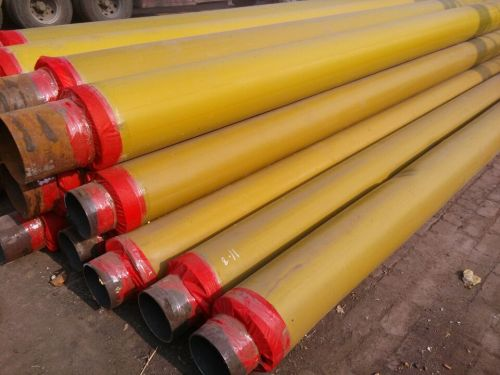一、在设计和施工中,一定要真正了解供热管道直埋敷设方式分为有补偿直埋敷设及无补偿直埋敷设两种方式,的确控制两种方式各自的工作原理,特性及其应用场所,以便在设计上合理选用,施工上平安、牢靠、经济。
First, in the design and construction, we must really understand that the direct burial laying of heating pipelines can be divided into compensated direct burial laying and non-compensated direct burial laying. We must control the working principles, characteristics and application sites of the two methods, so as to make rational selection in design and safe, reliable and economical construction.
1.要控制概念:有补偿直埋敷设方式,是经过管线自然补偿和补偿器(如方形和波纹管补偿器)来处理管道热伸长量的,从而使热应力为*小;无补偿直埋敷设,简单地说就是管道在受热时没有任何补偿措施,而是靠管材自身强度来吸收热应力。
1. First of all, we should control the concepts: there is a compensated direct burial laying method, which is to deal with the thermal elongation of pipeline by natural compensation and compensator (such as square and bellows compensator), so that the thermal stress is * small; non-compensated direct burial laying simply means that the pipeline does not have any compensation measures when heated, but relies on the pipe itself. Body strength absorbs thermal stress.
2.无补偿敷设方式的根本原理:在装置管道时,给管道加热到一定温度,然后将管道焊接固定,当管道恢复到装置温度时(温度降低),管道预先接受了一定的拉应力。当管道通热工作时,随着温度的升高,管道应力为零,当继续升温时,管道的压应力增加,当温度升到工作温度时,管道的压应力(热应力)仍小于许用应力。这样,管道能够不用补偿安装而正常工作了。这种无补偿方式应用第四强度理论,施工时需求对管道预热,施工比拟费事,但国内外已有大量工程理论,理论计算牢靠,能确保平安。另一种无补偿方式是近几年由我国北京煤气热力设计院提出的计算办法和应力分类采用安定性剖析,应用第三强度理论。这种方式充沛发挥钢材塑性潜力,施工便当,无需预热。

2. The basic principle of non-compensated laying method: when installing pipeline, heating pipeline to a certain temperature first, then welding and fixing pipeline, when the pipeline restores to the installation temperature (temperature decreases), the pipeline accepts a certain tensile stress in advance. When the pipeline is heated, with the increase of temperature, the stress of the pipeline is zero. When the temperature continues to rise, the pressure stress of the pipeline increases. When the temperature rises to the working temperature, the pressure stress (thermal stress) of the pipeline is still less than the allowable stress. In this way, the pipeline can work normally without compensation installation. This non-compensatory method applies the fourth strength theory, which needs to preheat the pipeline during construction. It is difficult to compare the construction. However, there are a lot of engineering theories at home and abroad. The theoretical calculation is reliable and can ensure safety. Another non-compensatory method is the stability analysis and the third strength theory for the calculation method and stress classification proposed by Beijing Gas Thermal Design Institute in recent years. In this way, the plastic potential of steel can be fully developed, and the construction is convenient without preheating.
3.两种敷设埋设深度思索不同要素。
3. Consider the different elements of two laying depths.
(1)当肯定采用有补偿直埋敷设方式时,埋设深度只思索由于空中荷载的作用不会毁坏管道的稳定便可,从经济、施工便当等方面思索。当采用有补偿直埋敷设方式时,尽量浅埋,普通覆土厚度大于0.6米即可,且与管径大小无关。
(1) When compensated direct burial is definitely adopted, the burial depth only considers that the stability of pipeline will not be destroyed due to the action of air load, and considers from the aspects of economy and construction convenience. When compensated direct burial is adopted, shallow burial should be used as far as possible. The thickness of common overlying soil is more than 0.6 meters, and it has nothing to do with the diameter.
(2)当采用无补偿直埋敷设方式时,埋设深度要思索管道的稳定请求,稳定性主要与覆土厚度有关,普通比有补偿埋得深,当采用不预热的无补偿直埋敷设管道时,*小覆土深度应按《城市热网设计标准》(CJJ34-90)第7.2.15条执行,覆土厚度应与管径大小成正比。
(2) When using non-compensated direct burial method, the burial depth should consider the stability requirements of pipelines. The stability is mainly related to the thickness of overlying soil, which is generally deeper than that with compensation. When using non-preheated direct buried pipelines without compensation, * the depth of small overlying soil should be in accordance with Article 7.2.15 of the Urban Heat Network Design Standard (CJJ34-90). The thickness of the overlying soil should be proportional to the diameter of the pipe.
4.设计中终究采用无补偿敷设还是有补偿敷设方式,准绳是直管道较长,中间分支较少,供热介质不超越100℃时,应优先选用无补偿敷设方式,否则,应思索有补偿敷设方式。详细的热网主干线应采用无补偿敷设方式,而分支庭院管网则应采用有补偿敷设方式,但目前有的设计者偏爱有补偿敷设,应倡导优化设计。
4. In the design, the non-compensated laying or compensated laying should be adopted eventually. The criterion is that the straight pipeline is longer, the middle branches are fewer, and the non-compensated laying should be preferred when the heating medium does not exceed 100 C. Otherwise, the compensated laying method should be considered. Detailed heat network trunk lines should be laid without compensation, while branch courtyard pipeline networks should be laid with compensation. However, the current designers prefer to lay with compensation, and should advocate optimal design.
Thank you for reading, this article source: polyurethane insulation pipe manufacturers more content and questions please click: http://www.sdhpgy.com we will continue to work hard to provide you with services, thank you for your support!







